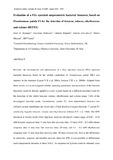- CERES Home
- →
- Cranfield Health
- →
- Staff publications - Cranfield Health
- →
- View Item
JavaScript is disabled for your browser. Some features of this site may not work without it.
| dc.contributor.author | Rasinger, Josef D. | |
| dc.contributor.author | Marrazza, Giovanna | |
| dc.contributor.author | Briganti, Fabrizio | |
| dc.contributor.author | Scozzafava, Andrea | |
| dc.contributor.author | Mascini, Marco | |
| dc.contributor.author | Turner, Anthony P. F. | |
| dc.date.accessioned | 2009-06-04T18:55:33Z | |
| dc.date.available | 2009-06-04T18:55:33Z | |
| dc.date.issued | 2005 | |
| dc.identifier.citation | Josef D. Rasinger; Giovanna Marrazza; Fabrizio Briganti; Andrea Scozzafava; Marco Mascini; A. P. F. Turner Evaluation of an FIA Operated Amperometric Bacterial Biosensor, Based on Pseudomonas Putida F1 for the Detection of Benzene, Toluene, Ethylbenzene, and Xylenes (BTEX), Analytical Letters, Vol 38, Iss 10 pages 1531-1547 | en_UK |
| dc.identifier.issn | 1532-236X | |
| dc.identifier.uri | http://dx.doi.org/10.1081/AL-200065793 | |
| dc.identifier.uri | http://hdl.handle.net/1826/3414 | |
| dc.description.abstract | Recently, the development and optimization of a flow injection analysis (FIA) operated bacterial biosensor based on the aerobic catabolism of Pseudomonas putida ML2 was reported in the literature (Lanyon et al. 2004, 2005). By adapting information from these reports, we investigated whether operating parameters and procedures of the benzene biosensor could be directly applied to a new system based on a different bacterial strain for the detection of the whole benzene, toluene, ethylbenzene, and xylenes range. Cells of the investigated bacterial strain, Pseudomonas putida F1, were immobilized between two cellulose acetate membranes and fixed onto a Clark dissolved oxygen electrode. The P. putida F1 aerobically degrades benzene, toluene, and ethylbenzene (BTE) (Cho et al. 2000). The BTE biosensor in kinetic mode FIA displayed a linear range of 0.02-0.14 mM benzene (response time: 5 min, base-line recovery time: 15 min), 0.05-0.2 mM toluene (response time: 8 min, baseline recovery time: 20 min), and 0.1-0.2 mM ethylbenzene (response time: 12 min, baseline recovery time: 30 min), respectively. Due to the differences in sensitivity, response, and baseline recovery times for BTE, it was possible to differentiate each compound in mixtures of these volatile organic compounds (VOCs). No response for xylenes could be obtained since they cannot be completely metabolized by this bacterial strain. However, it was reported that the range of compounds degradable by P. putida F1 can possibly be expanded by cultivating the cells on different carbon sources (Choi et al. 2003). The sensor showed good intra- and interassay reproducibility, and all obtained results were comparable with those reported in the literature. The demonstrated reproducibility and the simplicity and ease of use as well as the portability for in situ measurements indicates that the biosensor could be suitable as a reliable initial warning device for elevated BTE levels in indoor and outdoor environments. | en_UK |
| dc.language.iso | en | en_UK |
| dc.publisher | Taylor and Francis | en_UK |
| dc.subject | Flow injection analysis | en_UK |
| dc.subject | benzene | en_UK |
| dc.subject | toluene | en_UK |
| dc.subject | ethylbenzene | en_UK |
| dc.subject | xylenes | en_UK |
| dc.subject | volatile organic compounds | en_UK |
| dc.title | Evaluation of an FIA Operated Amperometric Bacterial Biosensor, Based on Pseudomonas Putida F1 for the Detection of Benzene, Toluene, Ethylbenzene, and Xylenes (BTEX) | en_UK |
| dc.type | Postprint | en_UK |
